#isfahan acid attacks
Text
Crisis over suspected Iran schoolgirl poisonings escalates
It remains unclear who or what is responsible since the alleged poisonings began in November in the Shiite holy city of Qom.
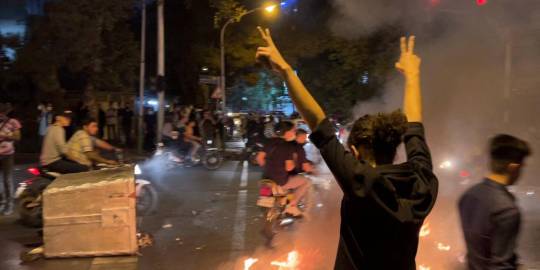
DUBAI, United Arab Emirates: A crisis over suspected poisonings targeting Iranian schoolgirls escalated Sunday as authorities acknowledged over 50 schools were struck in a wave of possible cases. The poisonings have spread further fear among parents as Iran has faced months of unrest.
It remains unclear who or what is responsible since the alleged poisonings began in November in the Shiite holy city of Qom. Reports now suggest schools across 21 of Iran’s 30 provinces have seen suspected cases, with girls’ schools the site of nearly all the incidents.
The attacks have raised fears that other girls could be poisoned, apparently just for going to school. Education for girls has never been challenged in the more than 40 years since the 1979 Islamic Revolution. Iran has been calling on the Taliban in neighboring Afghanistan to allow girls and women return to school and universities.
Interior Minister Ahmad Vahidi on Saturday said, without elaborating, that investigators recovered “suspicious samples” in the course of their investigations into the incidents, according to the state-run IRNA news agency. He called for calm among the public, while also accusing the “enemy’s media terrorism” of inciting more panic over the alleged poisonings.
However, it wasn’t until the poisonings received international media attention that hard-line President Ebrahim Raisi announced an investigation into the incidents on Wednesday.
On Sunday, Raisi told the Cabinet, following a report read by Intelligence Minister Ismail Khatib, that the root of the poisonings must be uncovered and confronted. He described the alleged attacks as a “crime against humanity for creating anxiety among student and parents.”
Vahidi said at least 52 schools had been affected by suspected poisonings. Iranian media reports have put the number of schools at over 60. At least one boy’s school reportedly has been affected.
Videos of upset parents and schoolgirls in emergency rooms with IVs in their arms have flooded social media. Making sense of the crisis remains challenging, given that nearly 100 journalists have been detained by Iran since the start of protests in September over the death of 22-year-old Mahsa Amini. She had been detained by the country’s morality police and later died.
The security force crackdown on those protests has seen at least 530 people killed and 19,700 others detained, according to Human Rights Activists in Iran.
The children affected in the poisonings reportedly complained of headaches, heart palpitations, feeling lethargic or otherwise unable to move. Some described smelling tangerines, chlorine or cleaning agents.
Reports suggest at least 400 schoolchildren have fallen ill since November. Vahidi, the interior minister, said in his statement that two girls remain in hospital because of underlying chronic conditions.
As more attacks were reported Sunday, videos were posted on social media showing children complaining about pain in the legs, abdomen and dizziness. State media have mainly referred to these as “hysteric reactions.”
Since the outbreak, no one was reported in critical condition and there have been no reports of fatalities.
Attacks on women have happened in the past in Iran, most recently with a wave of acid attacks in 2014 around the city of Isfahan, at the time believed to have been carried out by hard-liners targeting women for how they dressed.
Speculation in Iran’s tightly controlled state media has focused on the possibility of exile groups or foreign powers being behind the poisonings. That was also repeatedly alleged during the recent protests without evidence. In recent days, Germany’s foreign minister, a White House official and others have called on Iran to do more to protect schoolgirls — a concern Iran’s Foreign Ministry has dismissed as “crocodile tears.”
However, the U.S. Commission on International Religious Freedom noted that Iran has “continued to tolerate attacks against women and girls for months” amid the recent protests.
“These poisonings are occurring in an environment where Iranian officials have impunity for the harassment, assault, rape, torture and execution of women peacefully asserting their freedom of religion or belief,” Sharon Kleinbaum of the commission said in a statement.
Suspicion in Iran has fallen on possible hard-liners for carrying out the suspected poisonings. Iranian journalists, including Jamileh Kadivar, a prominent former reformist lawmaker at Tehran’s Ettelaat newspaper, have cited a supposed communique from a group calling itself Fidayeen Velayat that purportedly said that girls’ education “is considered forbidden” and threatened to “spread the poisoning of girls throughout Iran” if girls’ schools remain open.
Iranian officials have not acknowledged any group called Fidayeen Velayat, which roughly translates to English as “Devotees of the Guardianship.” However, Kadivar’s mention of the threat in print comes as she remains influential within Iranian politics and has ties to its theocratic ruling class. The head of the Ettelaat newspaper also is appointed by Supreme Leader Ayatollah Ali Khamenei.
Kadivar wrote Saturday that another possibility is “mass hysteria.” There have been previous cases of this over the last decades, most recently in Afghanistan from 2009 through 2012. Then, the World Health Organization wrote about so-called “mass psychogenic illnesses” affecting hundreds of girls in schools across the country.
“Reports of stench smells preceding the appearance of symptoms have given credit to the theory of mass poisoning,” WHO wrote at the time. “However, investigations into the causes of these outbreaks have yielded no such evidence so far.”
Iran has not acknowledged asking the world health body for assistance in its investigation. WHO did not immediately respond to a request for comment Sunday.
However, Kadivar also noted that hard-liners in Iranian governments in the past carried out so-called “chain murders” of activists and others in the 1990s. She also referenced the killings by Islamic vigilantes in 2002 in the city of Kerman, when one victim was stoned to death and others were tied up and thrown into a swimming pool, where they drowned. She described those vigilantes as being members of the Basij, an all-volunteer force in Iran’s paramilitary Revolutionary Guard.
“The common denominator of all of them is their extreme thinking, intellectual stagnation and rigid religious view that allowed them to have committed such violent actions,” Kadivar wrote.
0 notes
Photo


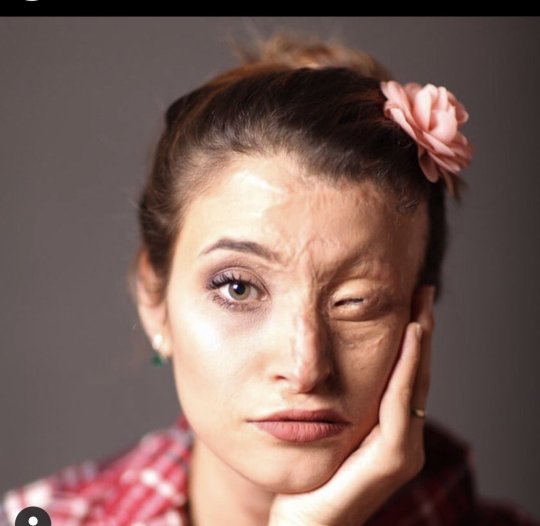
Back in 2014, Marzieh Ebrahimi had an appointment with a dentist and was stuck in traffic in the central Iranian province of Isfahan. She rolled down her car’s window only to see a huge volume of pure acid splashed on her face. Unfortunately, she lost part of her face and the cornea of an eye in the acid attack.
Police never caught the perpetrators, as it is usually the case despite the fact that the street was surveyed by video cameras.
All these horrible acts were directed towards women who were not wearing conservative outfits.
Many Iranians believe that these attacks were made in complicity with different authorities to discourage women from adopting a more liberal way of dressing. But both national and local authorities denied any involvement.
#Marzieh Ebrahimi#islam#acid attack#hijab#hijabi#religion#islamic violence#isfahan acid attacks#Iran#religion is a mental illness#criticism of islam#criticism of religion#most feminist religion
534 notes
·
View notes
Photo
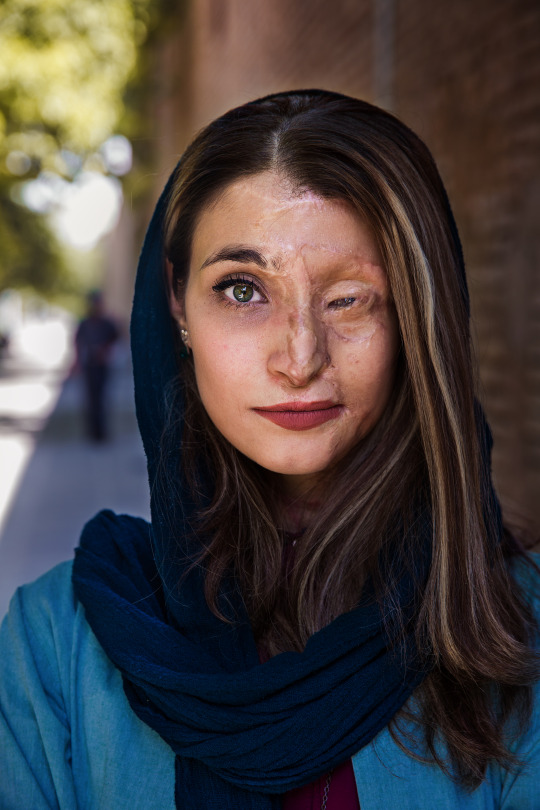
She is Marzieh, one of the strongest women I have ever met. I took this photo a while ago, in Iran and today, after having her consent, I decided to post it. Marzieh was driving in Isfahan, Iran, six years ago, when two men on a motorcycle came close to her car. One of them threw acid on her face and then they ran away. Police never caught them, although the street was surveyed by video cameras. There were a few other similar cases in Isfahan, in the same year, and the perpetrators have never been caught. All these horrible acts were directed towards women who were not wearing conservative outfits. Many Iranians believe that these attacks were made in complicity with different authorities to discourage women from adopting a more liberal way of dressing. But both national and local authorities denied any involvement. Today Marzieh is trying to raise awareness about these terrible attacks and advocates for the ban of acid sales. Although she started to cry when she remembered that horrible day, she wanted to tell me the whole story. Then she smiled again. It was the smile of a powerful woman, who found the strength and courage to overcome the suffering and to fight for her cause every single day, so this would not happen again to other women. Dear Marzieh, incredible women like you are the reason I’m doing this project. Thank you so much for showing me the purest form of beauty.
6K notes
·
View notes
Text
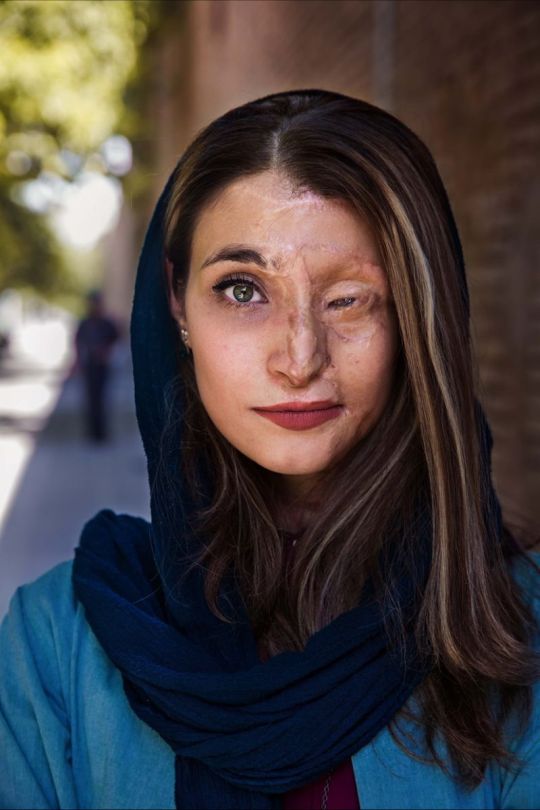
She is Marzieh, one of the strongest women I have ever met. She was driving in Isfahan, Iran, eight years ago, when two men on a motorcycle came close to her car. One of them threw acid on her face and then they ran away.
Police never caught them, although the street was surveyed by video cameras. There were a few other similar cases in Isfahan, in the same year, and the perpetrators have never been caught. All these horrible acts were directed towards women who were not wearing conservative outfits.
Many Iranians believe that these attacks were made in complicity with different authorities to discourage women from adopting a more liberal way of dressing. But both national and local authorities denied any involvement.
Today Marzieh is trying to raise awareness about these terrible attacks and advocates for the ban of acid sales. Although she started to cry when she remembered that horrible day, she wanted to tell me the whole story. Then she smiled again. It was the smile of a powerful woman, who found the strength and courage to overcome the suffering and to fight for her cause every single day, so this would not happen again to other women.
Dear Marzieh, incredible women like you are the reason I’m doing this project. Thank you so much for showing me the purest form of beauty.
10 notes
·
View notes
Text
The security forces of the Islamic Republic of Iran aided in the release of a man who reportedly shot three young women in the back while they were riding bikes in the city of Isfahan in August.
Persian language media outside of Iran reported on Wednesday about the alleged Iranian regime misconduct.
The US government outlet Radio Farda reported that “According to the mother of one of the shot girls, the officers first asked them not to leak the news so that they could find out which person or group did that. In less than 48 hours, the accused is identified and arrested; a 35-year-old man, according to the victims. However, according to the family of one of the victims, the security officials advised not to sue him, and at the hospital when they settled the bill, they said that if you want the hospital to pay the cost of the hospital, you have to consent.”'
Al Arabiya Farsi wrote the alleged suspect “was arrested with the help of security forces in 48 hours, but was released on bail in less than a month. Shargh newspaper wrote in a report that a man shot several women and at least one man in Isfahan on Thursday, August 19. Three young women were shot in the street and all three said they were shot in the back with a rifle, apparently a hunting shotgun, so that they had to go to medical facilities. “
Al Arabiya added that “While attending the hospital, one of the families found out that at least five people had been hospitalized for this reason. The report states that the bad behavior of the shooter's family, on the one hand, and the history of such violence in Isfahan, on the other, led several families to seek legal attention to the incident” in the media.
Sheina Vojoudi, an Iranian dissident who fled to Germany to escape persecution, said that the ”Basij attack civilians on the streets, especially women, if according to them the women don’t have a proper hijab. No one in Iran can do something like that and be released on bail except when they are allowed by Khamenei to fire at will or Basij or somehow related to one of the Islamic Republic’s organs. When there is a private complainant, it is impossible to be released without their consent. Only someone related to the regime can commit a crime like this and then force the complainants to consent.”
The Basij is a para-military force of young and fanatically pro-Iranian regime men.
Vojoudi added that “In a speech on June 7, 2017 [Ali] Khamenei [The Supreme leader of the Islamic Republic of Iran] gave full power to his supporters to act ‘independently like they are in a battlefield, fire at will.”’
She noted that Khamenei said, “Sometimes key think tanks and cultural and political institutions fall into disarray and stagnation, and when that happens, commanders of the soft war should recognize their duty, make decisions and act in a fire at will manner.”
Radio Farda reported that “In recent years, many women have been arrested by the police or attacked by other groups for failing to comply with the law on compulsory hijab in Iran. The most famous case being the acid attack on women in Isfahan. In September of 2014, after some religious figures in the city of Isfahan called for confronting the ‘unveiled,’ several motorcyclists in the city sprayed acid on the faces of girls and women. Since then until a few years later, judicial and security officials repeatedly spoke of pursuing the case and trying to arrest the accused, but in July 2018, the lawyer for the victims of the Isfahan acid attacks announced that the case would be closed without finding the accused or defendants. The victims of this incident have been paid from the fund of the Beit al-Mal by court order.”
Beit al Mal is an Arabic phrase and means "House of Wealth” and provided compensation for the injuries to the women who suffered acid attacks.
In 2014, an EU parliament lawmaker statement noted that "acid attacks against women have occurred again in Iran; this time at least twelve young girls have been attacked in the city of Isfahan. The attackers’ motives are supposed violations of the female dress code in Iran, which requires women to cover their hair in public with a veil. All of the victims were young women who were driving with their veil down; one of them has lost an eye and has very serious burns all over her body.”
Separately, an Iranian opposition Telegram news channel reported that Iranian Vice President Mohsen Rezaee warned that Iran will take action against “The 10,000 Jews living in Iran” if Israel “makes a mistake.” The Middle East Media Research Institute on Tuesday posted a translation of the threat targeting Iranian Jews.
3 notes
·
View notes
Photo
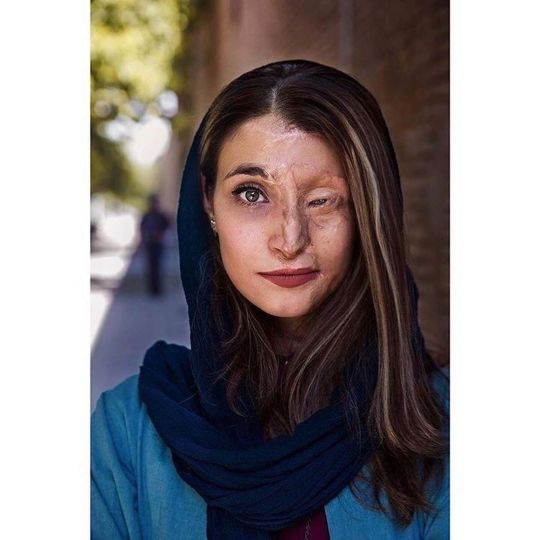
Western feminist could care less about true female oppression ・・・ This is Marzieh. She was driving in Isfahan, Iran, six years ago, when two men on a motorcycle came close to her car. One of them threw acid on her face and then they ran away. ⠀⠀⠀⠀⠀⠀⠀⠀ Police never caught them, although the street was surveyed by video cameras. There were a few other similar cases in Isfahan, in the same year, and the perpetrators have never been caught. All these horrible acts were directed towards women who were not wearing conservative outfits. ⠀⠀⠀⠀⠀⠀⠀⠀ Many Iranians believe that these attacks were made in complicity with different authorities to discourage women from adopting a more liberal way of dressing. But both national and local authorities denied any involvement. ⠀⠀⠀⠀⠀⠀⠀⠀ Today Marzieh is trying to raise awareness about these terrible attacks and advocates for the ban of acid sales. Although she started to cry when she remembered that horrible day, she wanted to tell me the whole story. Then she smiled again. It was the smile of a powerful woman, who found the strength and courage to overcome the suffering and to fight for her cause every single day, so this would not happen again to other women. https://www.instagram.com/p/CGVMbcnF0Z1/?igshid=19du2l8z5yr8w
4 notes
·
View notes
Photo

Marzieh Ebrahimi, survivor of the 2014 serial acid attacks on women in Esfahan, Iran. Back in 2014, Marzieh had an appointment with a dentist and was stuck in traffic in the central Iranian province of Isfahan. She rolled down her car’s window only to see a huge volume of pure acid splashed on her face.Unfortunately, she lost part of her face and the cornea of an eye in the acid attack. She is now happily married and the news of her marriage made headlines in media, particularly in social media. (Source)
4K notes
·
View notes
Text
Alarming rates of acid attacks in Iran back on the rise
Alarming rates of acid attacks in Iran back on the rise
Last month, unidentified people also attacked two women in Maashour, within the Ahwaz province, according to Iranian news agencies.
After almost a year of calm, spraying people with burning acid has returned in Iran where a family of four has been attacked on Saturday in Sharada, within Isfahan province, Iran’s top tourist destination.
Last month, unidentified people also attacked two women in…
View On WordPress
0 notes
Text
ACID ATTACKS AGAINST WOMEN WHO ARE NOT PROPERLY VEILED!
ACID ATTACKS AGAINST WOMEN WHO ARE NOT PROPERLY VEILED!
Muslims consider women who are not properly veiled an outrage, a provocation. Dousing women with acid for being not properly veiled is pleasing to Allah! After almost a year of calm, spraying people with burning acid has returned in Iran where a family of four has been attacked in Sharada, within Isfahan province, Iran’s top tourist destination.
Last month, unidentified people also attacked two…
View On WordPress
0 notes